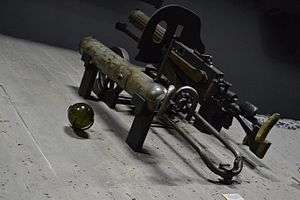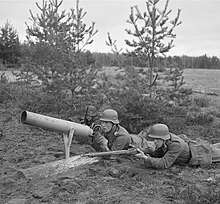Ampulomet
The Ampulomet (Russian: 125-мм ампуломёт образца 1941 года, also rendered Ampulomyot, ampulla mortar, etc., lit. "ampule/vial thrower" cf. миномёт) was an expedient anti-tank weapon which launched a 125 mm incendiary projectile made of spherical glass.[4][5] This weapon was introduced in 1941 and used (to a limited degree) by the Red Army in World War II, but by 1942 was largely obsolete.[6]
| Ampulomet | |
|---|---|
 Ampulomet and PM M1910 machine gun at the Museum of the Battle of Stalingrad. | |
| Place of origin | Soviet Union |
| Service history | |
| Used by | |
| Wars | World War II |
| Production history | |
| Manufacturer | Lenningrad |
| Specifications | |
| Mass | 26 kg (57 lb 5 oz) |
| Length | 1 m (3 ft 3 in) |
| Barrel length | .84 m (2 ft 9 in)[1] |
| Crew | 3[2] |
| Shell | Separate loading black powder charge and AZh-2 projectile containing KS incendiary. |
| Shell weight | 1.5 kg (3 lb 5 oz)[3] |
| Caliber | 125 mm (4.9 in) |
| Recoil | None |
| Elevation | 0° to +12° |
| Traverse | 360°[1] |
| Rate of fire | 8 rpm |
| Muzzle velocity | 50 m/s (160 ft/s) |
| Maximum firing range | 250 m (820 ft)[1] |
Design

The weapon consisted of an unrifled tube with a crude breach mounted on a Y shaped pedestal which pivoted on trunnions to provide elevation. Two breech mounted inverted horns were provided for traverse/elevation and a simple inclinometer for targeting and range calculation. A black powder charge was inserted into the breech and fired by a percussion cap to propel the AZh-2 glass ampule.[1] The ampules were filled with an incendiary mixture known as KS. KS was a mixture of 80% phosphorus and 20% sulfur which ignited when exposed to air. The burning mixture created a bright flame, thick white smoke and would burn for up to three minutes at temperatures between 800–1,000 °C (1,470–1,830 °F). The burning liquid would seep through vision slots or engine grilles on a tank and ignite ammunition or fuel as well as choke and blind the crew.[7]
References
- Chamberlain, Peter (1975). Infantry, mountain, and airborne guns. Gander, Terry. New York: Arco. p. 63. ISBN 0668038195. OCLC 2067391.
- Steve J. Zaloga; Leland S. Ness (1998). Red Army Handbook 1939-1945. Sutton Pub. p. 197. ISBN 978-0-7509-1740-7.
- David M. Glantz (2005). Companion To Colossus Reborn: Key Documents And Statistics. University Press of Kansas. p. 154. ISBN 978-0-7006-1359-5.
- Círculo Militar (Buenos Aires, Argentina) (1945). Revista. Calle de Viamonte. p. 562.
- Gordon L. Rottman (2007). Soviet Rifleman 1941-45. Osprey Publishing. pp. 30–. ISBN 978-1-84603-127-4.
- Gordon L. Rottman (2005). World War II Infantry Anti-Tank Tactics. Osprey Publishing. pp. 47–. ISBN 978-1-84176-842-7.
- Natzvaladze, Yury (1996). The Trophies Of The Red Army During The Great Patriotic War 1941-1945. Volume 1. Scottsdale, Arizona: Land O'Sun Printers. pp. 31–34.
| Wikimedia Commons has media related to 125 mm ampulomet model 1941. |